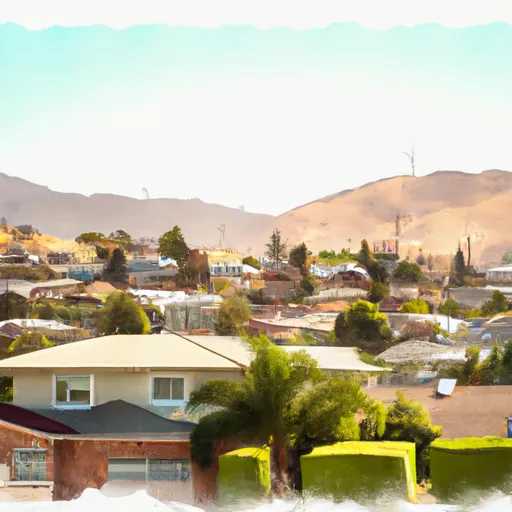-
 Snoflo Premium
Snoflo Premium
Get unlimited access to all our content
With no Ad interruptions! - Start Your Free Trial Login with existing account
Summerland
Eden Index
Climate
9.5
•
Recreation
3.1
•
Community
3.9
•
Safeguard
5.8/10

Located in Santa Barbara County, Summerland, California is a charming coastal community that offers a pleasant Mediterranean climate and a range of outdoor recreation opportunities. The climate in Summerland is characterized by mild, dry summers and cool, wet winters. Average temperatures range from 60°F (15°C) in winter to 75°F (24°C) in summer, making it an ideal destination for outdoor activities year-round.
Summerland is also known for its beautiful beaches and stunning views of the Pacific Ocean. The area is home to several hydrology constituents, including the Carpinteria Salt Marsh Reserve and the Carpinteria Bluffs Nature Preserve. These natural areas provide a habitat for various species of plants and wildlife, making it an excellent spot for birdwatching, hiking, and nature photography.
Outdoor enthusiasts can enjoy a range of activities such as surfing, paddleboarding, kayaking, and fishing in the nearby coastal waters. The area also offers opportunities for hiking and mountain biking in the nearby Los Padres National Forest, which boasts scenic trails and breathtaking vistas.
Whether you're looking to explore nature, soak up the sun on the beach, or engage in outdoor recreational activities, Summerland, California offers a delightful climate and an array of options for nature lovers and adventure seekers.
What is the Eden Index?
The Snoflo Eden Index serves as a comprehensive rating system for regions, evaluating their desirability through a holistic assessment of climate health, outdoor recreation opportunities, and natural disaster risk, acknowledging the profound impact of these factors on livability and well-being.
Climate Health Indicator (CHI): 9.5
Summerland receives approximately
583mm of rain per year,
with humidity levels near 77%
and air temperatures averaging around
16°C.
Summerland has a plant hardyness factor of
10, meaning
plants and agriculture in this region tend to thrive here all year round.
By considering the ideal temperature range, reliable water supplies, clean air, and stable seasonal rain or snowpacks, the Climate Health Indicator (CHI) underscores the significance of a healthy climate as the foundation for quality living.
A healthy climate is paramount for ensuring a high quality of life and livability in a region, fostering both physical well-being and environmental harmony. This can be characterized by ideal temperatures, reliable access to water supplies, clean air, and consistent seasonal rain or snowpacks.
Weather Forecast
Streamflow Conditions
Central California Coastal
Area Rivers
Central California Coastal
Snowpack Depths
Central California Coastal
Reservoir Storage Capacity
Central California Coastal
Groundwater Levels
Recreational Opportunity Index (ROI): 3.1
The Recreational Opportunity Index (ROI) recognizes the value of outdoor recreational options, such as parks, hiking trails, camping sites, and fishing spots, while acknowledging that climate plays a pivotal role in ensuring the comfort and consistency of these experiences.
Access to outdoor recreational opportunities, encompassing activities such as parks, hiking, camping, and fishing, is crucial for overall well-being, and the climate plays a pivotal role in enabling and enhancing these experiences, ensuring that individuals can engage in nature-based activities comfortably and consistently.
Camping Areas
| Campground | Campsites | Reservations | Toilets | Showers | Elevation |
|---|---|---|---|---|---|
| Middle Santa Ynez | 13 | 1,599 ft | |||
| Los Prietos | 37 | 1,088 ft | |||
| Upper Oso | 25 | 1,166 ft |
Catastrophe Safeguard Index (CSI):
The Catastrophe Safeguard Index (CSI) recognizes that natural disaster risk, encompassing floods, fires, hurricanes, and tornadoes, can drastically affect safety and the overall appeal of an area.
The level of natural disaster risk in a region significantly affects safety and the overall livability, with climate change amplifying these risks by potentially increasing the frequency and intensity of events like floods, fires, hurricanes, and tornadoes, thereby posing substantial challenges to community resilience and well-being.
Community Resilience Indicator (CRI): 3.9
The Community Resilience Indicator (CRI) recognizes that education, healthcare, and socioeconomics are crucial to the well-being of a region. The CRI acknowledges the profound impact of these elements on residents' overall quality of life. By evaluating educational resources, healthcare accessibility, and economic inclusivity, the index captures the essential aspects that contribute to a thriving community, fostering resident satisfaction, equity, and social cohesion.

